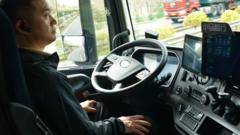The massive driverless lorries gliding down the Beijing-Tianjin expressway represent a transformative shift in China's transport industry. While human "safety drivers" remain on board to comply with governmental regulations, the dependence on human control is gradually diminishing. Engineer Huo Kangtian, 32, expresses mixed feelings about the technology, balancing his initial apprehensions with growing confidence in the autonomous trucks' capabilities. "I felt a bit scared the first time I drove an autonomous truck," he admits, but acknowledges their safety after benchmark tests.
Initially under his supervision, the truck activates self-driving mode seamlessly, maneuvering through tolls and highways. Huo describes the advantages of automation, citing reduced stress and the potential for less fatigue. He approaches job security with caution, suggesting that uncertainty looms over the future of human drivers.
Pony AI, a key player in this sector, asserts that the journey towards full automation could enhance transport efficiency significantly, leading to decreased labor costs and improved handling of demanding driving conditions. According to Yang Ruigang, a technology professor, the essence lies in maximizing operational cost-efficiency, with a goal of transforming labor expenses to almost zero.
Nonetheless, several hurdles remain, especially regarding public acceptance. A past incident wherein three university students were killed by an autonomous vehicle has led to a wariness surrounding the technology. Economist Chim Lee emphasizes that enhancing public perception is critical for the future of driverless trucks in China, especially given recent passenger vehicle accidents.
In Hefei, Anhui Province, however, optimism about driverless delivery vehicles is taking root. Rino.ai's Gary Huang elaborates on how their autonomous delivery vans are designed to streamline logistics from distribution hubs to local addresses, even drawing interest from international markets, like Australia.
Currently, more than 500 driverless vans operate across over 50 Chinese cities, with Hefei leading in autonomous vehicle adaptation. Regional director Zhang Qichen states that the efficiency of autonomous systems is already translating into faster delivery speeds and notable cost savings for businesses.
Challenges continue to surround the rollout of driverless technology for heavy vehicles, especially in unpredictable driving conditions. Experts believe that within five years, we could witness widespread adoption of heavy autonomous trucks in specific conditions, albeit with necessary technological advancements and improved public perception.
As the landscape of transportation evolves, the balance between technological development and societal acceptance remains an essential theme in the deployment of driverless vehicles in China. The path ahead may not be straightforward, but confidence in achieving autonomous transportation continues to grow.
Initially under his supervision, the truck activates self-driving mode seamlessly, maneuvering through tolls and highways. Huo describes the advantages of automation, citing reduced stress and the potential for less fatigue. He approaches job security with caution, suggesting that uncertainty looms over the future of human drivers.
Pony AI, a key player in this sector, asserts that the journey towards full automation could enhance transport efficiency significantly, leading to decreased labor costs and improved handling of demanding driving conditions. According to Yang Ruigang, a technology professor, the essence lies in maximizing operational cost-efficiency, with a goal of transforming labor expenses to almost zero.
Nonetheless, several hurdles remain, especially regarding public acceptance. A past incident wherein three university students were killed by an autonomous vehicle has led to a wariness surrounding the technology. Economist Chim Lee emphasizes that enhancing public perception is critical for the future of driverless trucks in China, especially given recent passenger vehicle accidents.
In Hefei, Anhui Province, however, optimism about driverless delivery vehicles is taking root. Rino.ai's Gary Huang elaborates on how their autonomous delivery vans are designed to streamline logistics from distribution hubs to local addresses, even drawing interest from international markets, like Australia.
Currently, more than 500 driverless vans operate across over 50 Chinese cities, with Hefei leading in autonomous vehicle adaptation. Regional director Zhang Qichen states that the efficiency of autonomous systems is already translating into faster delivery speeds and notable cost savings for businesses.
Challenges continue to surround the rollout of driverless technology for heavy vehicles, especially in unpredictable driving conditions. Experts believe that within five years, we could witness widespread adoption of heavy autonomous trucks in specific conditions, albeit with necessary technological advancements and improved public perception.
As the landscape of transportation evolves, the balance between technological development and societal acceptance remains an essential theme in the deployment of driverless vehicles in China. The path ahead may not be straightforward, but confidence in achieving autonomous transportation continues to grow.


















